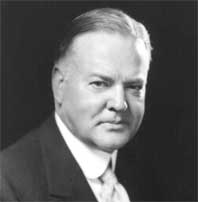The Causes of the Great Depression
by Marc Schulman
The 1920's were a period of rapid economic growth. All Americans did not equally share that economic growth. By 1929 factory inventories were rising. Despite rising inventory(when inventory grows it means products are not being sold) and signs of an economic slowdown, stock prices continued to soar. The stock rise was fueled by easy credit that allowed people to buy stocks on margin. With easy credit, people could buy stock by putting down only 10% of the cost in cash.
The stock market continued its advance. The Dow Jones industrial average reached a peak of 381. For the next month, the market moved sideways, until Wednesday, October 23, 1929, when an avalanche of sell orders arrived. The markets lost $4 Billion that day. The next day the markets continued their downward spiral. On Friday the major bankers of the day gathered and tried to bolster the market. That held for one day. On the following Monday and Tuesday known as Black Monday and Black Tuesday, the market lost nearly 13% and 12% of its value on each of the days. An initial bottom occurred on November 13th when the Dow Jones Industrial Average closed at 198. After this fall the markets recovered for a few months. It then began a steady slide that ended in 1932 with the Dow Jones at 41.22, an 80% drop from its high.

The prevailing view in the Republican Party at the time was that government should not become involved in the world of business. President Hoover however did not subscribe to that view, instead became actively involved in the economy. He summoned the leaders of industry and convinced them to increase their investment, and not to lower wages. He also influenced the Federal Reserve to increase lending. Finally he asked Congress for $140 million for federal infrastructure projects.
The stock market crash is the moment that we look to as the beginning of the Great Depression, however it alone did not cause the depression. It was the failure of the banking system that did the most harm. There were thousands of banks in the United States at the time. Throughout the 1920's, on average 500 banks failed a year. In the year that followed the stock crash, many weak banks failed. Runs on banks happened more often. The trouble with American banks reached a new level when the Bank of United States was forced to close its doors. The Federal Reserve attempted to save the bank but failed and this failure combined with the size of the bank( it held $280 million in deposits) eliminated any remaining confidence in the American banking system. Six hundred banks failed in the last 60 days of the 1930.
The final setbacks to the American economy began with the raising of tariffs under the Hawley Smoot Act. This was followed by a series of decisions by nations to get off the gold standard. The decision of Great Britain to go off the gold standard was the final blow to International Trade- that trade plummeted from 36 Billion in 1928 to 16 Billion in 1931. It also marked the final blow to American banks, 2294 banks failed in 1931. In a final blow to the economy President Hoover proposed an increase in income taxes. By early 1930 ten million people representing 20% of the work force were out of work. The prevailing view in the Republican Party at the time was that the government should not become involved in the world of business. President Hoover, however, did not subscribe to that view, instead became actively involved in the economy. He summoned the leaders of industry and convinced them to increase their investment, and not to lower wages. Hoover also influenced the Federal Reserve to increase lending. Finally, he asked Congress for $140 million for federal infrastructure projects.
The stock market crash is the moment that we look to as the beginning of the Great Depression; however, it alone did not cause the depression. It was the failure of the banking system that did the most harm. There were thousands of banks in the United States at the time. Throughout the 1920's, on average 500 banks failed a year. In the year that followed the stock crash, many weak banks failed. Runs on banks happened more often. The trouble with American banks reached a new level when the Bank of United States was forced to close its doors. The Federal Reserve attempted to save the bank but failed, and this failure combined with the size of the bank( it held $280 million in deposits) eliminated any remaining confidence in the American banking system. Six hundred banks failed in the last 60 days of 1930.
The final setbacks to the American economy began with the raising of tariffs under the Hawley Smoot Act. This was followed by a series of decisions by nations to get off the gold standard. The choice of Great Britain to go off the gold standard was the final blow to International Trade- that trade plummeted from 36 Billion in 1928 to 16 Billion in 1931. It also marked the final blow to American banks, 2294 banks failed in 1931. In a final blow to the economy, President Hoover proposed an increase in income taxes. By early 1930 ten million people representing 20% of the workforce were out of work.
 >
>